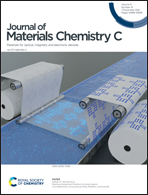Configurationally stable helical tetradentate Pt(ii) complexes for organic light-emitting diodes with circularly polarized electroluminescence†
Abstract
In this study, three pairs of tetradentate Pt(II) enantiomers with a helical structure are reported. By changing a six-membered to a five-membered metallocycle and replacing quinoline by benzo[h]quinoline with greater steric hindrance, the configurational stability of the Pt(II) complex is improved to be maintained at sublimation temperature. Pt1 with fused 6/6/6 metallocycles can be separated into a pair of enantiomers, but racemization occurs at room temperature. The Pt2 enantiomers with fused 5/6/6 metallocycles demonstrate obvious phosphorescent circularly polarized luminescence (CPL) properties with dissymmetry factors (|gPL|) of 6.77 × 10−3 in CH2Cl2 solutions at room temperature. After replacing a quinoline unit by a benzo[h]quinoline group, the larger overlap between the second quinoline and benzo[h]quinoline results in the good configurational stability of Pt3 enantiomers at evaporation temperature. The evaporated organic light-emitting diodes (OLEDs) with Pt1 and Pt2 emitters exhibit good device performances with a maximum luminance of 39 072 cd m−2 and a maximum external quantum efficiency (EQEmax) of 14.2%. Because of the good configurational stability of Pt3 enantiomers, the evaporated OLEDs with Pt3 enantiomers show symmetrical circularly polarized electroluminescence (CPEL) signals with |gEL| of 6.81 × 10−4, as well as an EQEmax of 12.6%.



 Please wait while we load your content...
Please wait while we load your content...